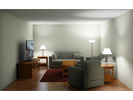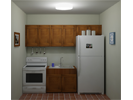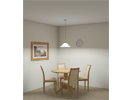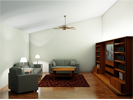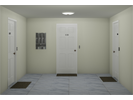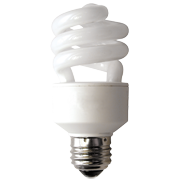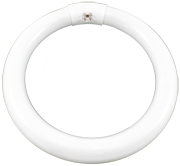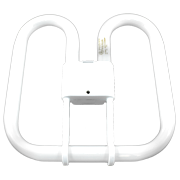
Compact and Circline Fluorescent
Compact fluorescent lamps (CFLs) offer significantly greater efficacy and longer life than incandescent bulbs. CFLs and circline fluorescent bulbs are diffuse, nondirectional light sources that are suitable for ambient lighting and task lighting. CFLs are available with a wide variety of color rendering properties (CRI) and correlated color temperatures (CCT).
CFLs are available with different bases, including the screwbase, 2- and 4-pin base, and GU24 "twist and lock" base. Most circline fluorescent bulbs are pin-based. All fluorescent bulbs require ballasts to provide the starting voltage and limit the electrical current during bulb operation. Screwbase CFLs and GU24 CFLs have integrated ballasts, which are permanently attached to the base of the bulb. CFLs with 2- and 4-pin bases require separate ballasts, and are more common in commercial and industrial settings.
Screwbase CFLs are available in a wide variety of styles including a bare spiral and covered A-lamp, globe, capsule, reflector, and candelabra. The bare spiral is the most commonly used. Covered A-lamp, globe and capsule CFLs have built-in diffusers and are suitable when the fixture does not hide the bulb from view (e.g., downlight pendant over a table); the diffuser enclosure may be glass or breakage-resistant plastic. CFL reflectors are designed to aim light in a particular direction, and are suitable for task lighting or for creating a soft wash of light. CFL candelabras, also known as candle CFLs, are available for decorative lighting, such as in wall sconces.
Screwbase CFLs screw directly into medium-base bulb sockets used by incandescent bulbs, however, screwbase CFLs are heavier and may be larger than incandescent bulbs. Check to see if plug-in fixtures would become unstable due to the heavier weight of the screwbase CFL. It may be necessary to install a harp extender to raise a table bulb shade to make more room for the CFL. When relamping incandescent recessed downlights, other technologies, such as LEDs, are more suitable than CFLs.
Some CFLs and circline fluorescent bulbs are dimmable, but this must be indicated on the package by the manufacturer. For use with a three-way fixture, look for bulbs marked "three-way" to provide a high, medium, or low output. Circline fluorescent bulbs require a compatible dimmable ballast.
Cautions
- CFLs have a slight warm-up period of one to three minutes before reaching full brightness. This is not a flaw in the technology. The slow start-up allows the CFL to maintain constant light output while it is operating.
- A CFL can appear dimmer than expected. This can be avoided by using the "Divide by 3 Rule." A CFL requires fewer watts than an incandescent to give off the same abount of light. Manufacturers use a 4:1 ratio for the wattage of an incandescent relative to a CFL. However, CFL performance can vary based on temperature and position, so a 3:1 ratio is recommended instead. For example, replace a 60 watt incandescent with a CFL that uses 20 watts, not 15 watts. A fraction of the energy will still be used while avoiding the possible disappointment of a dim lamp.
- Fluorescent bulbs contain a small amount of mercury. Follow recommended procedures when a fluorescent bulb breaks.
- Most fluorescent bulbs operate poorly in extremely cold temperatures. Check the bulb manufacturer's recommendations for minimum and maximum ambient temperature before installing a CFL outdoors or in an enclosed fixture where ambient temperatures can be very high. If the bulbs are used outdoors in cold climates, they should only be used in enclosed fixtures.
- Most CFLs provide less light output when operated in the base-down position.
- Ballasts that have poor power quality characteristics may interfere with television controls, timers, and other household appliances.
- Screwbase CFLs are larger and heavier than the incandescent bulbs they may replace. Some fixtures may not be able to accommodate the additional weight.
- Measure the dimensions of the fixture before purchasing a CFL to see if the bulb will fit.
- If you have a fixture with a three-way or other multi-level switch, make sure the bulb packaging says it is compatible.
Example Patterns
